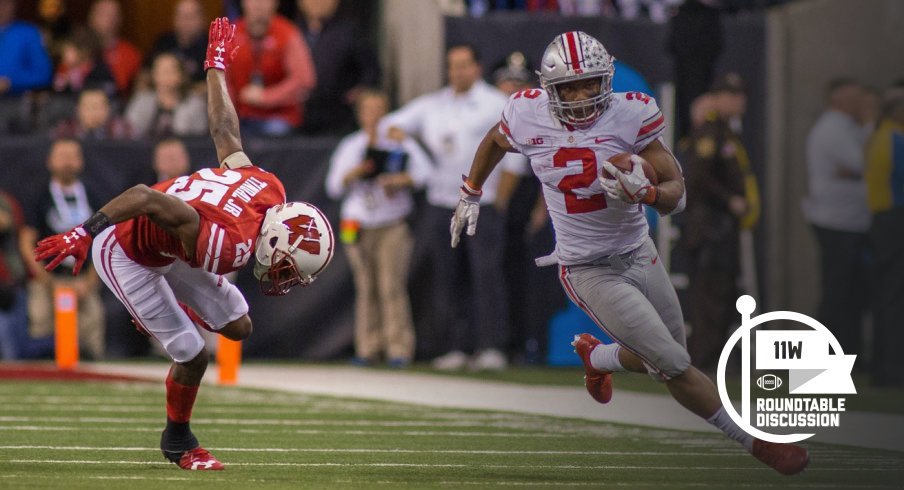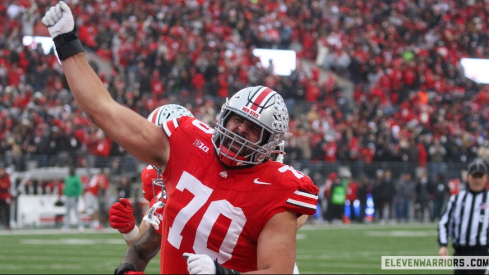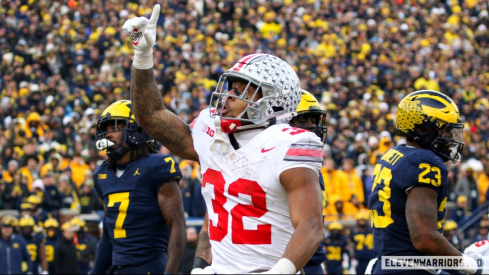Ohio State's win over Wisconsin capturing the Big Ten crown was barely 12 hours old when the Buckeyes found out they would be on the sidelines for the College Football Playoff.
Focus now turns toward Cotton Bowl prep for Clay Helton's USC Trojans, a program the Buckeyes have struggled with over the years.
With kickoff three weeks from tonight, we look back at Ohio State's memorable night in Indianapolis, the CFP snub and other reflections in this week's 11W roundtable featuring Kyle Jones, David Wertheim and Andrew Lind.
So, let’s get right to it. Did the committee select the correct four teams? Why or why not? What’s your biggest issue, if anything, with the committee’s logic as explained by Kirby Hocutt?
Kyle: They definitely got the first three right. Clemson, Georgia, and Oklahoma proved to be the most consistent teams throughout the year, and though none escaped the regular season without a loss, all three more than passed the eye test as they ran through the second half of the season. There was no perfect case for the fourth seed, no matter who they’d chosen. Cases can be (and were) made against Alabama, Ohio State, Wisconsin, USC, and UCF, as all had major flaws on their resume. That all said, win-loss record should always be the first tiebreaker in my book, so I don’t have an issue with other teams making it over Ohio State. Just like in pro football, if you want to make the playoffs, just win more football games.
David: Yes, I think they did. As much as I hoped Ohio State would be selected if nothing else than to rub it in to my friends who go to Alabama, you cannot excuse a 31-point loss to 7-5 Iowa when the Crimson Tide are lurking in the wings for a spot. You just can't. I think Alabama is better than-and would beat- Ohio State, so I really do believe that the committee got the four teams right, and in the correct order. As for Hocutt, I learned after he said that there was "very little separation between teams 5-8" to just tune him out. I don't like to listen to them talk anyway. A note for next year: Every Tuesday night, just listen to the rankings come out and then turn the television off or switch it to Wheel of Fortune. You can probably catch the prize puzzle! Nothing good comes after Rece Davis reads the teams.
Andrew: Absolutely not. Before championship weekend, Hocutt said there was little to no separation between No. 5 (Alabama) and No. 8 (Ohio State), so it was a surprise to see the Buckeyes didn’t leapfrog the idle Crimson Tide after winning the Big Ten title over undefeated Wisconsin.
I viewed Alabama in the same way I did Ohio State in 2015, when it lost to Michigan State late in the season and then missed the playoff despite only one loss. Those Buckeyes, like the Crimson Tide this year, lacked a signature win and lost their only high-profile game that season.
Of course, making the playoff without a conference title has happened before, so it’s not like the committee always sides with a conference champion. But last year’s Ohio State squad also had wins over four Top 10 opponents.
It all just felt to me as if the committee was trying to avoid pairing Clemson and Ohio State, and instead based it off the two previous meetings between the Tigers and Crimson Tide. And they ignored any previous precedent or anything they said in the weeks leading up to that decision in the process.
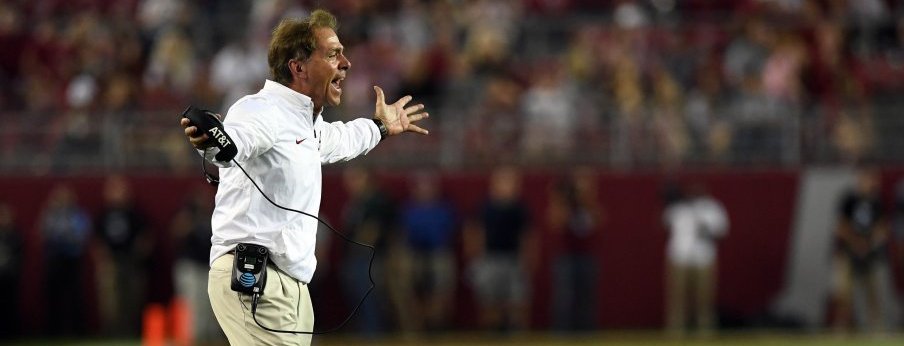
It won’t happen overnight but expansion will ultimately come at some point. If you’re the college football overlord, how would you modify the existing format? Six teams with top two teams getting a bye? Eight teams with automatic bids for the Power Five conference champs and three at-large squads with at least one nod going to a non-Power Five? Something else?
Andrew: The best route moving forward is either sticking with four or moving to eight. Six, to me, makes very little sense.
Who is to say No. 1 Clemson and No. 2 Oklahoma, for example, were more deserving of a bye than one-loss and third-ranked Georgia? The off week would surely give them an advantage I don’t believe would be warranted in years like this.
Four, to be, has always been the perfect number. While one conference champion is sure to be left out, it will — typically — take the most deserving teams. I’m not sure that remains the case if you expand to eight.
Does Wisconsin deserve a shot at a national title as an at-large team when it just lost a defacto playoff game last week? I don’t think so. But I digress, as I feel the same way about Alabama.
If it is expanded to eight teams, the five conference champions, the best Group of Five team and two at-large teams are the way to go. And I don’t think there should be more than two teams from one conference allowed.
David: I really like the eight team, automatic bid, etc. formula that was posed in this question. I think it makes the most sense. Something that could be cool would be to have the first game on the campus of whichever team has the top seed, as somewhat of a reward for finishing in the top four. Then everything goes back to "normal," or basically what we have seen in these previous four years.
Kyle: Eight seems the best, but that renders the conference championship games somewhat meaningless. Unlike college hoops, in which every team gets to participate in the conference tournament, these games are only for the cream of the crop, and could feel duplicative to the first round of an with-team tournament. But good luck selling the conferences on giving up that revenue stream anyway. That all said, I don’t have a problem with using same the way teams are currently selected for an eight-team playoff, as it’s much hard to muster up the same intensity for the ninth-place team’s inclusion when most know they’re probably not getting all the way through three rounds.
Because the committee selects the playoff teams so quickly, winning a B1G championship gets lost in the jet wash. What surprised you the most – good or bad - during Ohio State’s 27-21 win over the Badgers?
Kyle: Ohio State absolutely controlled both sides of the line of scrimmage all night, which was a bit surprising to me. You expect the Buckeyes to have the athletic advantage on the edges against a team like the Badgers, but with those massive and well-coached units in the trenches, usually the boys from Madison more than hold their own. Even though everyone remembers the turnovers, Ohio State ran out the clock with that long, seven-minute drive in the fourth quarter by playing Wisconsin’s style of physical football, not by throwing screens or running jet sweeps.
Andrew: You’re absolutely right, and it was a strange dynamic to have been on the field with the team celebrating on Saturday night to then see Urban Meyer, J.T. Barrett and Chris Worley completely devastated during a press conference the next afternoon just because they missed out on the playoff.
As I pointed out on Twitter, though, there’s nothing for them to hang their heads about after beating Michigan for a sixth-straight time, winning the Big Ten and then having a shot to beat USC for the first time in seemingly forever. It’s just weird because it feels like they should be playing for so much more.
As for the championship game itself, there was a real shot for the Buckeyes to be up 35-0 at the half, and I think that’s what ultimately cost them a shot at the playoff. The team has been woefully inconsistent all year, sometimes looking like world beaters and the next looking incompetent when trying to cover a simple route from tight end.
David: I really thought the situation with J.T. Barrett would be resolved in a better way. He looked bad. Really bad. I expected him to either not play or play much better than he did. I certainly did not foresee Urban Meyer playing a hobbled quarterback who obviously didn't have it that night. I've been calling all year for Haskins (I even bought his jersey for god's sake) and was expecting Barrett to either perform well or for the Dwayne Train to get rolling. Neither of those things happened. It is a shame that one of the last memories we will have of J.T. Barrett is him putting up a clunker on a big stage. Yet again. Jerome Baker played well, at least.
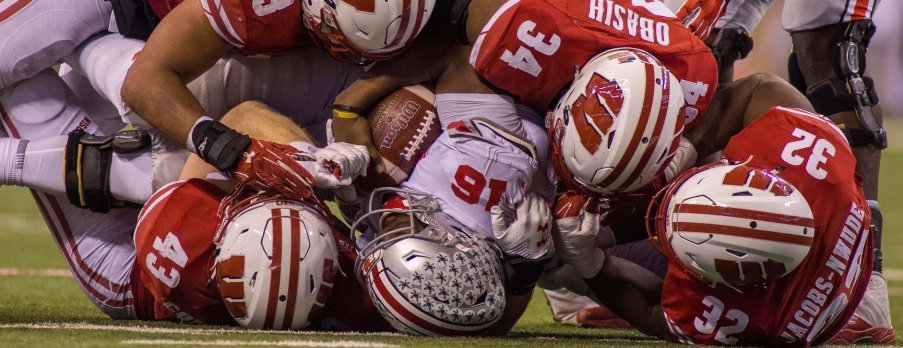
J.T. Barrett is obviously a legend entering his final game but should Urban make any effort to give Dwayne Haskins a look with an eye on next year as OSU takes on USC in the Cotton Bowl, especially when you consider Barrett’s 54% completion rate with 10 touchdowns and eight interceptions over his last five games starting with the Iowa debacle? Why or why not?
David: No. I think that move should have been made before the season, or after the Oklahoma game. But you don't bench J.T. Barrett for his final game ever now, after sticking with him throughout the whole year. Simple as that.
Kyle: No, let Barrett go out with a bang. He’s earned it. Haskins will benefit more from the three weeks of practice at this point, anyway, and he’ll get plenty of reps with the first team while J.T.’s knee gets back to full strength. But the senior QB is going up against a media and NFL darling in Sam Darnold on the other side, and it’s only fair to let a guy who’s given everything to the program be allowed to show what he’s got to all the pro scouts that will be watching.
Andrew: If the Buckeyes are leading by a few touchdowns in the fourth quarter and Meyer wants to give Barrett a curtain call, absolutely. But I think sending him and the rest of the senior class out with a win, especially against a quality opponent like USC — who many pegged to also make the playoff — is much more important to him.
Why not also get Baron Browning a lot more time at linebacker instead of Chris Worley, too. Or Chase Young instead of Jalyn Holmes? Or Jeffrey Okudah instead of surely NFL-bound Denzel Ward?
I’ve never been one to subscribe to the narrative sit your seniors with a “eye on next year” when they’ve already done so much for the program. They deserve one final game together.
That’s what spring ball is for.
J.K. Dobbins went for 174 yards rushing on 10.2 per carry against the Badgers while flashing that electric jump cut and a solid power finishing runs in traffic. His breakaway speed may not be as good as we thought early on but what’s the ceiling for Dobbins? Could he evolve into a top-five back in OSU history? Might he make a bid for the Heisman down the road?
Andrew: I was a huge fan of Dobbins from the time I first viewed his tape when I took this job. I’m fact, I thought he was the best running back in his class, even when the staff still chased after Florida State running back Cam Akers.
They were wise to stop their pursuit of Akers when Dobbins said he’d look around if they kept it up.
Anyway, he’s been the Buckeyes’ best running back all year, and he’s only going to get better. Sure, he doesn’t have the breakaway speed right now, but I’m positive that’s something he’s going to work on this offseason.
If he continues on the path he’s on — and Meyer and the offense actually gets him the ball 20 times a game like he should — then the Heisman Trophy is absolutely within reach.
Kyle: He’s got as good a chance as anyone to be considered one of the all-time greats at the most glamorous position in school history. He has such great balance that he easily runs through arm tackles, he falls forward for extra yards, and he has the vision to identify holes with the burst to get through them in a hurry, so all the tools are already in place. With a new quarterback at the helm next year, he’ll be in Heisman race immediately, but it may all depend on how long Mike Weber stays in Columbus. As long as both backs are in school, the coaches will understandably look to limit carries in an effort to keep them both fresh at the end of the season, knowing games like last weekend’s tough contest against Wisconsin could be on the horizon. The biggest hurdle for his Heisman campaign may be his head coach, though, as Meyer’s offenses have never prioritized a running back over the quarterback, and given the direction the game has gone in the past decade, that philosophy isn’t likely to change soon.
David: Yes and yes. If Dwayne Haskins is indeed the quarterback next year as most expect, it will force the defense to respect the passing game of Ohio State, something they did not have to really do this year. Dobbins was still able to average 7.7 yards per carry this year, which is truly remarkable. Granted, the offensive line will suffer an inevitable downgrade with the losses of Jamarco Jones and Billy Price, but I think that will be offset by the emergence of a dominant passing game. Dobbins could be really, really good when it is all said and done.
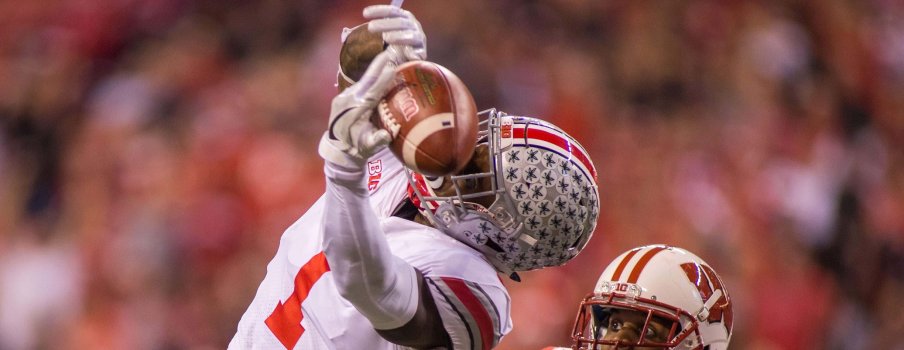
Johnnie Dixon ranks third on the team in receiving yards with 413 despite just 17 catches which ranks eighth. Did he get the ball thrown his way enough this year? Before the season started, after his epic spring game but history of injuries, would you have pegged him for more or less than he’s produced? Why or why not?
David: Certainly less. I learned after Torrance Gibson played really well in the 2016 Spring Game that those games don't matter at all. I thought Dixon was just going to get hurt again, as much as it pains me to say it. He really surprised everyone this year, and you have to applaud him for sticking through during the tough times. He has been a veteran leader on a unit that has needed one.
Andrew: I feel like the yardage sounds about right, but I would have imagined it came of a few more receptions.
It’s been a while since Ohio State has a 1,000-yard receiver, and to think he or any other receiver, for that matter, was capable of that kind of yardage given the way the Buckeyes seem to spread the wealth — so to speak — would be foolish.
In all honestly, I was just happy to Dixon stay healthy this season. His confidence has only grown as a result... though he did have a bad drop in the Big Ten Championship.
I think he might take the biggest step forward this offseason of any receiver because of that, and I anticipate he’ll be a go-to option for Burrow or Haskins next fall.
Kyle: I never expected him to put up these numbers, and his reemergence has been one of the highlights of the season. That said, much of that production came on one route - a middle hook on the “Mesh” concept - that sprung him for a number of opportunities for yards after the catch. But as opponents became more aware of the concept, the OSU staff had to disguise it further, moving other players into that hook route and leaving Dixon to produce in other ways, where he’s struggled, such as dropping a sure touchdown pass on a perfectly thrown deep post in the third quarter last Saturday night.
Sticking with the wide receivers, which one has impressed you the most through 13 games and why? Which has been the biggest disappoint and why?
David: Dixon has to have impressed me the most, along with K.J. Hill. I don't remember Hill dropping a pass all year and he has been awfully solid on the short crossing routes and has been very efficient in making yards after the catch. Austin Mack stepped up when he needed to, and Parris Campbell is really, really fast. Binjimen Victor is a guy that I thought would get going but never did, although I think J.T. Barrett not being able to hit him (see the three awful fade throws in the Michigan State game for your prime example) really hurt. I think he can, and will, get it going with Haskins under center next year.
Kyle: K.J. Hill is easily the most impressive, and it’s not really close. He’s had the most consistent hands by far of any within the group of six that sees the field regularly, and while he doesn’t quite have the same explosiveness as Parris Campbell, he’s still pretty tough to take down in the open field. The biggest disappointment is probably a tie between Bin Victor and Austin Mack, as both have now been in the program for two full seasons and have yet to consistently catch the football, despite that being their number one job as the ‘X’ receiver. These guys don’t have to outrun people down the field, and are bigger than virtually every defender they’ll see in coverage, so they already have an advantage. However, neither has turned into a reliable target on third downs or in the red zone. Hopefully we see some improvement after bowl prep, but I’m not holding my breath.
Andrew: I’m going to go with Austin Mack.
He doesn’t have the all-conference stats some expected him to put up by now, but he’s always doing the small things that will make him a coach’s favorite player.
In fact, his reception — which involved him coming back to the ball — at Michigan helped keep alive a crucial drive. And then his block on a cornerback against Wisconsin sprung Parris Campbell for his long touchdown reception.
The Buckeye always say their running backs have to learn to block before they can contribute. I think the same thing goes for the wide receivers, and I think it shows that Mack is willing to do everything he can to win, even if he’s not getting the ball in his hands.
